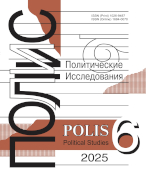Russia’ Regional Elites:
Whom They Consist of, and What Are the Tendencies of Their Evolution (I)
Gaman-Golutvina O.V.,
Dr. Sci. (Polit. Sci.), Corresponding Member of the Russian Academy of Sciences, Head of the Comparative Political Science Department, MGIMO University; President of the Russian Association of Political Science; Professor, National Research University Higher School of Economics; Editor-in-Chief of the journal “Comparative Politics”; member of the Public Chamber of the Russian Federation and the Public Council under the Ministry of Education and Science of the Russian Federation, Moscow, Russia, ogaman@mgimo.ru
elibrary_id: 250180 | ORCID: 0000-0002-2660-481X | RESEARCHER_ID: E-4046-2012
DOI: 10.17976/jpps/2004.02.02
Gaman-Golutvina O.V. Russia’ Regional Elites: Whom They Consist of, and What Are the Tendencies of Their Evolution (I) . – Polis. Political Studies. 2004. No. 2. https://doi.org/10.17976/jpps/2004.02.02
It is the results of a large research project, namely: The most influential people of Russia-2003, implemented last year by the Institute for Situational Analyses and New Technologies, that are made use of, and interpreted in the article. In it the author analyzes the composition of the ranks of Russia's regional elites, as well as mechanisms of their formation and rotation. The first part of the article, published in this issue, deals with political elites. As is demonstrated in it, in the course of the administrative-legal reform initiated in 2000, redistribution of political influence in favour of the center has taken place. Regional leaders have lost the status of political actors of federal significance. A regional politician's status and potential are now considerably dependent on his being well-connected in the structures of federal power and are determined to a large extent by support of influential politico-financial clans. According to the author's conclusion, ideological opposition is being replaced by fight for resources; pragmatism is being enthroned as the main principle of regional elites' interaction between themselves and with the center.
See also:
Durdin D.M.,
The “Image” of a Political Leader and Possibilities of Changing It. – Polis. Political Studies. 2000. No2
Glubotzky A.Yu., Kynev A.V.,
The Party Component of the Russian Regions’ Legislative Assemblies. – Polis. Political Studies. 2003. No6
Nazarchuk A.V.,
The concept of deliberative policy in modern political process. – Polis. Political Studies. 2011. No5
Nechayev V.D.,
Factors and Preconditions of Local Self-government’s Financial Autonomy. – Polis. Political Studies. 2004. No6
Gelman V.Ya., Lankina T.V.,
Political Diffusions under the Conditions of a Spatially Mixed Regime: Institution-building and Election of City Mayors in Russia. – Polis. Political Studies. 2007. No6




.jpg)






 print
print
.jpg)
.jpg)